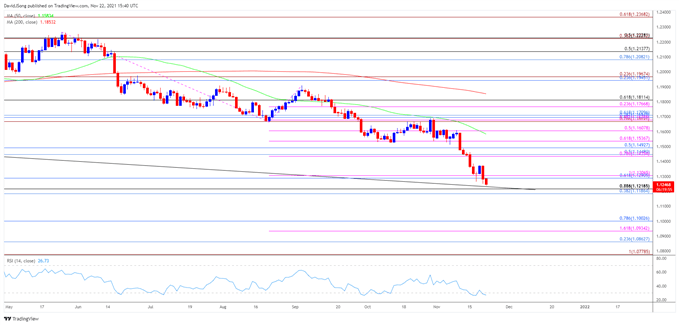EUR/USD Rate Talking Points
EUR/USD trades to a fresh monthly low (1.1236) as a number of states in Germany start to impose social restrictions to combat the rising number of COVID-19 cases, and the exchange rate may continue to give back the advance from the July 2020 low (1.1185) as long as the Relative Strength Index (RSI) holds in oversold territory.
EUR/USD Rate Weakness to Persist as RSI Holds in Oversold Zone
The bearish trend in EUR/USD looks poised to persist as Europe’s largest economy heads for another lockdown, and the exchange rate may continue to trade to fresh monthly lows until the RSI climbs back above 30 to indicate a textbook buy signal.
It remains to be seen if the European Central Bank (ECB) will respond to the renewed COVID-19 restrictions as President Christine Lagarde expects inflation to “increase further until the end of the year,” with the central bank head going onto say that “we must not rush into a premature tightening when faced with passing or supply-driven inflation shocks” while speaking in front of the Frankfurt European Banking Congress.
The comments suggests the ECB is in no rush to switch gears as “an undue tightening would represent an unwarranted headwind for the recovery,” and it seems as though the Governing Council will retain the current policy at its next meeting on December 16 as President Lagarde pledges to “focus on the medium term, not on current inflation numbers.”
In turn, the deviating paths between the ECB and Federal Reserve may keep EUR/USD under pressure as the Federal Open Market Committee (FOMC) carries out its exit strategy, but a further decline in the exchange rate may fuel the tilt in retail sentiment like the behavior seen earlier this year.
The IG Client Sentiment report shows 72.08% of traders are currently net-long EUR/USD, with the ratio of traders long to short standing at 2.58 to 1.
The number of traders net-long is 10.99% higher than yesterday and 0.77% higher from last week, while the number of traders net-short is 20.34% higher than yesterday and 3.65% lower from last week. The rise in net-long interest adds to the crowding behavior as 69.34% of traders were net-long EUR/USD last week, while the decline in net-short position comes as the exchange rate trades to a fresh monthly low (1.1236).
With that said, EUR/USD may continue to exhibit a bearish trend as rising COVID cases in Europe is likely to keep the ECB on its current course, and the exchange rate may approach the July 2020 low (1.1185) as long as the Relative Strength Index (RSI) holds below 30.
EUR/USD Rate Daily Chart
Source: Trading View
- Keep in mind, EUR/USD sits below the 200-Day SMA (1.1853) for the first time since April as the advance from the March low (1.1704) failed to produce a test of the January high (1.2350), with the moving average establishing a negative slope as the exchange rate traded to a fresh yearly lows in October.
- EUR/USD continues to depreciate in November, and the exchange rate mayattempt to test the July 2020 low (1.1185) as long as the Relative Strength Index (RSI) holds in oversold territory.
- The break/close below the 1.1290 (61.8% retracement) to 1.1310 (100% expansion) region brings the Fibonacci overlap around 1.1190 (38.2% retracement) to 1.1220 (78.6% retracement) on the radar, with a break of the July 2020 low (1.1185) opening up the 1.1000 (78.6% retracement) handle.
— Written by David Song, Currency Strategist
Follow me on Twitter at @DavidJSong



Be the first to comment